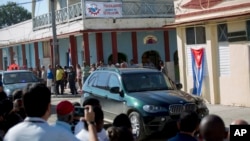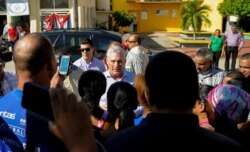GUANTANAMO, CUBA — President Miguel Diaz-Canel began the day in a small town overlooking the American naval base at Guantanamo Bay. He decried the U.S. trade embargo, then inspected a series of state-run enterprises alongside members of his Cabinet.
By mid-afternoon, he and his ministers held an hour-long discussion about agricultural productivity before an audience of university students.
Twelve hours after the day began, the 59-year-old president was shaking hands, kissing cheeks and singing on stage alongside performers in a government cultural center in the heart of Guantanamo, the capital of Cuba's easternmost province.
More than 18 months after Diaz-Canel assumed the presidency, The Associated Press was one of two foreign news organizations granted unprecedented access Thursday to what has become a signature activity of his administration, a whirlwind tour of one of Cuba's 14 far-flung provinces.
With their glad-handing and micro-detailed reviews of local public services and infrastructure, the tours have resurrected a Cuban leadership style that flourished under revolutionary leader Fidel Castro during his four decades in power. Castro's brother and successor, Raul, had virtually no interaction with the press or general public after taking over in 2008. Raul Castro ruled for a decade before he handed power to Diaz-Canel.
Castro, 88, remains first secretary of Cuba's Communist Party, and says he expects Diaz-Canel to assume that role in 2021 and serve for a decade, making him the most powerful figure in Cuba until at least 2031.
Until this week, foreign media had not been invited on his trips around Cuba, but they are painstakingly documented in Cuban state media and on ministers' social media accounts, which Diaz-Canel ordered his Cabinet members to open shortly after he took office.
A tall, powerfully built man with a raspy, monotone voice, Diaz-Canel has had almost no contact with the foreign press since taking office. He spoke only once to the AP and other international reporters on Thursday's tour.
“The Yankees keep squeezing but we keep resisting and winning,” he said, when asked about U.S. pressure by an AP journalist at the start of his swing through the town of Caimanera on Guantanamo Bay. “We will fight back. They will never defeat us, and with everyone's help we will keep advancing our ideas and the country will keep advancing.”
Cubans do not vote for their president and elections for local and national assembly are referenda that offer a choice of yes or no for state-selected candidates. There are no public opinion polls, and the National Assembly uniformly approves all legislation put before it by the executive branch.
Cubans freely criticize the government in private, and increasingly mock their leaders on social media. But repression of public dissent remains fierce and widespread, with state security agents harassing nonconformists ranging from independent journalists to ordinary citizens who complain about public services.
Despite the near-total power of the state and Communist Party in the Cuban system, control is not as easy to exert as it was when Cuba was isolated and kept afloat first by Soviet then Venezuelan aid. Cubans are increasingly connected to the outside world through the internet and air travel, and the island itself requires billions a year in tourism revenue and remittances from expatriates to family members on the island.
Diaz-Canel has said that communication with the public will be one of his government's top priorities, and Thursday's tour allowed foreign media a glimpse at his efforts to create a public image of openness, contact with ordinary people and concern for the minutest details of local administration and public services.
The president and his ministers visited more than a dozen sites around Guantanamo's capital and nearly towns, receiving detailed reports on production and improvement plans at facilities ranging from a milk plant to a plantain farm.
Foreign press were allowed to document three events during the day — a visit to a movie hall in the town of Caimanera, the forum with university students and a nighttime visit to Guantanamo's city center. There, just after 9 p.m., Diaz-Canel greeted musicians at a state-run cultural center, sang a snatch of music onstage with a performer, went from table to table at a government restaurant next door, then headed into the street to greet residents.
The events were highly orchestrated, with government supporters chanting “Long Live Diaz-Canel!” but had flashes of spontaneity. As Diaz-Canel prepared to board his SUV and depart, a woman pushed past security and insisted on passing the president a piece of paper that appeared to have a request for help on it.
After the president departed, most of those remaining around Guantanamo's central plaza were local government officials or dozens of hulking plainclothes security agents who maintained control of the area during Diaz-Canel's visit and kept close eyes on the foreign press and people in the street.
One of the few actual bystanders was David Acosta a 70-year-old retired state employee who said Diaz-Canel had shown himself to be a leader concerned about ordinary people.
“He's a president who follows our revolutionary traditions, takes care of the country's needs and doesn't hide those things that need improvement,” Acosta said.








